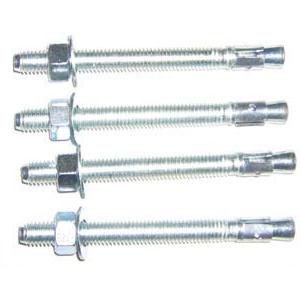In modern construction, a huge number of various hardware products are used. At the same time, it is inconceivable to do without the longest special fastener, which is called the "foundation bolt". He has another, less popular name - "hairpin".
Fastener Overview
By design, the foundation bolt is a long round rod made of steel. At its ends there is a thread designed for one of the sizes of nuts. For the production of these hardware products, different types of steel are used. They can easily be identified by the markings affixed to this fixture. The parameters of the foundation bolts are regulated by GOST 24379.1-80. It indicates the type, length, design, diameter and pitch, thread, steel grade. Detailed descriptions and drawings of various elements of these fasteners are also given there.
Depending on the nature of the load and the size, type of foundation, support structure, these bolts differ according to different criteria:
- according to operating conditions: design (power) and structural (lightly loaded);
- by design;
- by installation method: embedded and deaf;
- by the method of fixing in the foundation - monolithic in the base during its manufacture, on glue, on a cement-sand mixture, jammed.
Application area
The foundation bolt can be used in a variety of ways. Most often it is used to create reinforced concrete structures of complex configuration. With the help of foundation pins, durable joints are created with fixed bases. So widespread is the practice of using this fixture for the installation of large equipment (machine tools, conveyors). This is due to the very long length of the studs and the threaded connection. These features of the foundation bolts allow you to create a mount that perfectly resists small dynamic loads in the form of vibration of electric motors.
Types of foundation pins
According to GOST, all these fasteners are divided into 6 types. Foundation bolts come in different lengths and have different thread sizes at their ends. Depending on their design, they can have different mounts to the base. Below are the most common types of mounts of this kind:

- The bolt is curved. It can be of two subspecies: the rod is straight to a bend or bent at an acute angle (15-30 degrees). Fasteners of the second type can withstand heavy loads.
- Compound bolt. It is of two subspecies: with nuts according to GOST 5915-70 and GOST 10605-72. These bolts can be extended in length. The extension is carried out with the help of a steel coupling screwed into the fastener part fixed at the base.
- Bolt with anchor plate. There are three types. The first two have different upper nuts, while the third has a special shape anchor plate.
- The bolt is removable. This fastener is of three types. All of them differ among themselves with anchor fittings and an external nut. Removable fasteners can be of almost any length. This feature of them explains why anchor foundation bolts are so popular. GOST 24379.1-80 provides 3 types of performance of such fasteners. They differ depending on the diameter of the thread. Foundation anchor bolts are most often used in fastening equipment. They allow you to easily and simply mount or dismantle any machines.
- Straight bolt. This type of fastener is considered classic. Its lower edge can simply be welded to the reinforcement of the reinforced concrete structure before pouring it with concrete.
- Tapered end bolt. It differs from other types in the form of the end of the hardware, which is attached to the base. It has an expanding conical shape. Thanks to it, the foundation bolt is firmly fixed and it simply cannot be pulled out of concrete. There are several varieties of this type of fasteners.